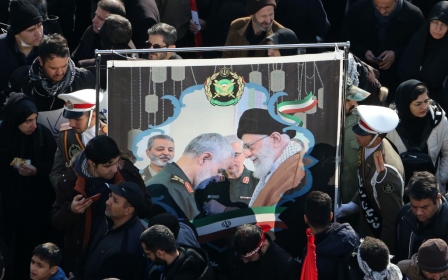The killing of Qassem Soleimani: Iran at a crossroads

Last October, Islamic State (IS) leader Abu Bakr al-Baghdadi died during a US raid in northwestern Syria. Two months later, a US drone strike killed Iranian Quds Force commander Qassem Soleimani in Baghdad.
In some sense, Baghdadi and Soleimani were byproducts of the US presence in the Middle East. Without Washington’s occupations and disastrous policies in the region, neither would have risen to their recent prominence.
Mutualistic relationship
If Baghdadi was created by the US occupation, then his rise in the years that followed was enabled by the Soleimani-sponsored purge in Iraq. Likewise, without the IS phenomenon, Soleimani’s impact throughout the region could have been significantly more confined. This strange, mutualistic relationship ended consecutively, almost proving its cause-and-effect nature.
Iranian Foreign Minister Mohammad Javad Zarif, who clashed with Soleimani just months earlier, said after the military leader’s death that he was “the most effective force” fighting IS, Nusra and al-Qaeda.
The US removed Iran's two enemies, Saddam Hussein and the Taliban, in less than two years
Zarif is well aware of the value of being an anti-IS warrior. Tehran, like many others in the region, is well aware of the simple and primitive strategy of the past decade. Whatever they do, it is all about “fighting IS”. This is a useful leverage to help advance tactical goals in the eyes of the international community.
As Baghdadi started to emerge on the scene, Iran’s sectarian purge in post-Saddam Iraq was a catalyst for him and for IS. It was also Iran’s first al-Qaeda moment.
After 9/11, as the US rushed to occupy Afghanistan and Iraq, Iran noticed a golden opportunity. Soleimani’s first crucial mission as leader of the Quds Force was in Afghanistan and involved “implicit coordination” with the US against Washington and Tehran’s mutual enemy: the Taliban. The US removed Iran’s two enemies, Saddam Hussein and the Taliban, in less than two years.
Historic juncture
The temporary and consensual marriage was similar to the symbiosis between Baghdadi and Soleimani. Neither ever acknowledged their co-dependency, but instead kept clashing on many fronts, threatening each other and even crossing the lines with physical attacks.
The US occupations of Afghanistan and Iraq marked a historic juncture, one where Iran could have set itself on the path of domestic normalisation, supporting the people’s demand for change in the region. Instead, Iran interpreted the 9/11 attacks as the US finding a new enemy: al-Qaeda.
A decade later, a second opportunity arrived with the Arab uprisings. Popular movements were growing, and the masses were asking for change - but Tehran chose to back the regional status quo, supporting governments in Iraq and Syria. Had it not done so, there could have been important opportunities for the reconciliation of ethnic and sectarian factions in both countries.
An Iran that defended change in the region would have helped to actualise the process of democratisation in neighbouring countries - and more importantly, at home - without external scare tactics. It would have softened the sectarian tensions antagonising the region, clearing the path for an entirely different discourse on the Middle East. Instead, Tehran thought it more prudent to extend its power through its allies.
Demise of the proxy strategy
In the early days of 2020, as over the past two decades, Iran finds itself once again at a crossroads. Although Iran is quite experienced with US aggression in the region and against Tehran, the current state of tension is different than that of the past.
Iran was able to withstand the longest conventional war of the 20th century (1980-88), during which the US supported Iraq. Iran has managed to withstand devastating economic sanctions. And while there have been many incidents over the last four decades, this is the first time that the US and Iran are having a direct confrontation at this level.
Soleimani’s killing represents the demise of the comfortable proxy strategy used by Iran for years. It also represents US recklessness and the nonexistence of Washington’s geopolitical perspective. The temporary marriage of the last two decades between the US and Iran is over.
The moment the Iraqis attacked the US embassy, things radically changed. It was not difficult to predict what Washington would think about the raid. The 1979 Tehran embassy crisis, when thousands of young people who proclaimed themselves as followers of Imam Khomeini took 52 US diplomats and citizens hostage, was also recalled by the Libyan embassy attack several years ago.
Iran's retaliation
In the wake of Soleimani’s assassination, questions began to fly over how Iran would retaliate. On Wednesday, Iran fired more than a dozen ballistic missiles towards two Iraqi military bases hosting US-led coalition personnel, with no reported casualties. Zarif said the strikes “concluded” Iran’s response, and US President Donald Trump subsequently noted that “Iran appears to be standing down, which is a good thing for all”.
After missing the last two decades of opportunities, Tehran should avoid another lost decade
Any further retaliation could easily ignite a war, the magnitude of which no one can possibly predict. As the US is the largest global military power - with almost zero geopolitical vision and no sound policy in the Middle East under Trump’s leadership - eschatological, end-of-times speculation is not off the table.
Over the last decade, especially after the Arab uprisings broke out, Iran has sought to compensate for centuries of geopolitical hunger with messianic sectarianism. After missing the last two decades of opportunities, Tehran should avoid another lost decade.
Had Iran chosen to support change in the region and domestically, we could have been witnessing a radically different political atmosphere today - one that could not have been stopped or destroyed by a drone missile.
The views expressed in this article belong to the author and do not necessarily reflect the editorial policy of Middle East Eye.
Middle East Eye propose une couverture et une analyse indépendantes et incomparables du Moyen-Orient, de l’Afrique du Nord et d’autres régions du monde. Pour en savoir plus sur la reprise de ce contenu et les frais qui s’appliquent, veuillez remplir ce formulaire [en anglais]. Pour en savoir plus sur MEE, cliquez ici [en anglais].







